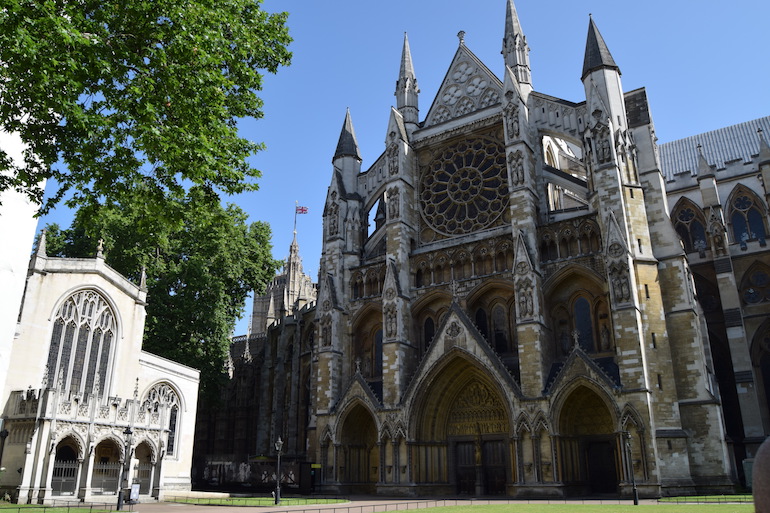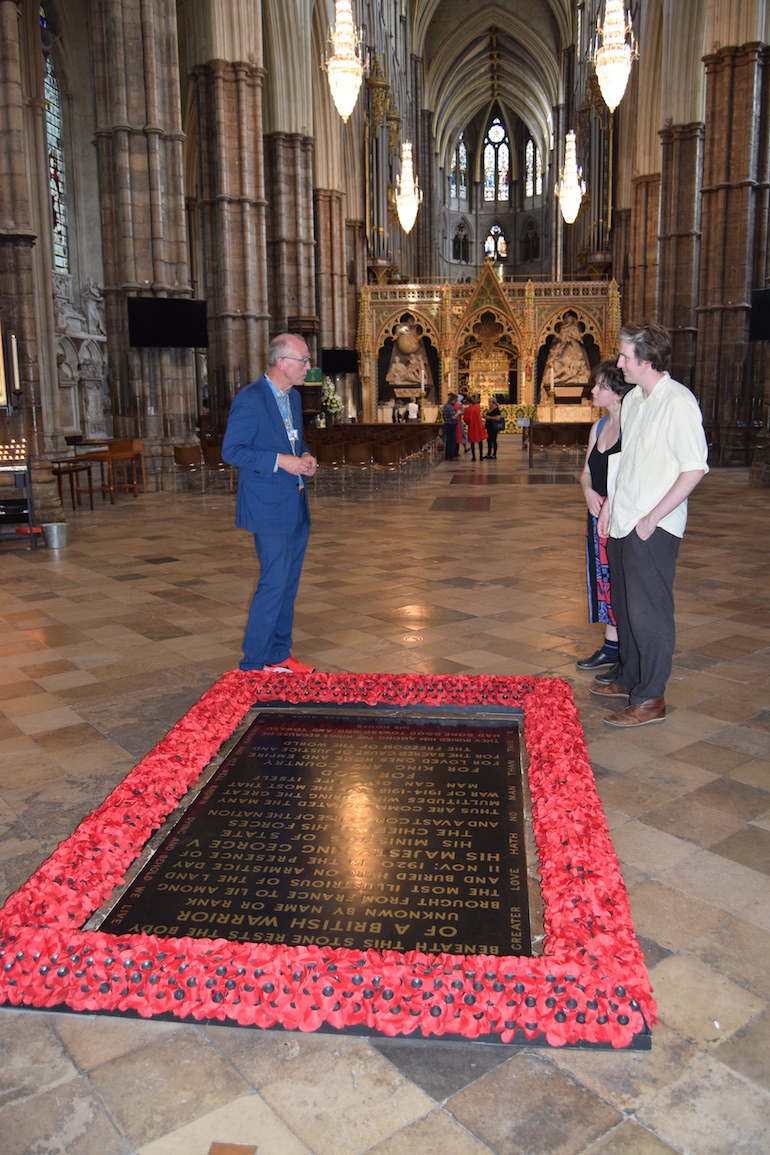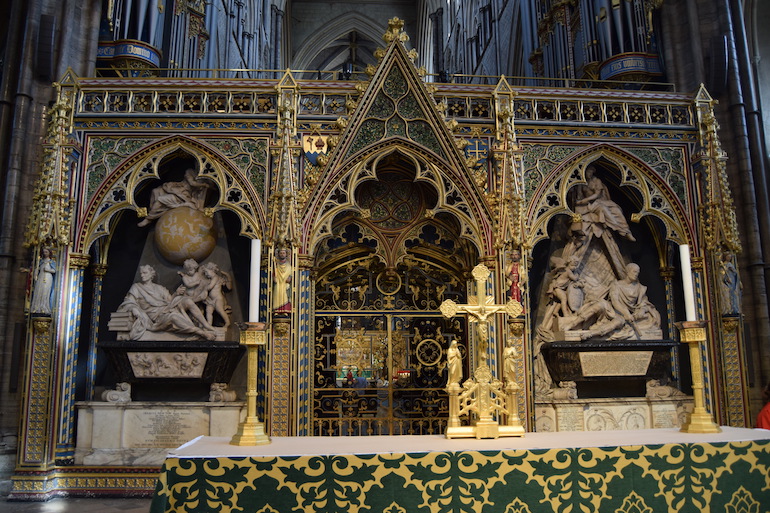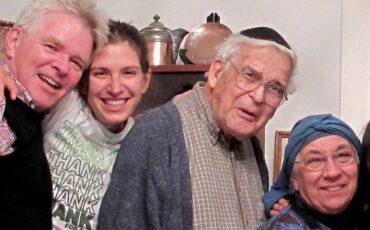As well as being the major royal church of the United Kingdom, Westminster Abbey contains the tombs of many famous people who were not born into royalty. Over 3,000 people are buried at Westminster Abbey – many forgotten by history – but it remains the final resting place for celebrated Britons. Others who are not buried there are honoured with commemorative plaques. Below are some of the famous Westminster Abbey burials including well-known explorers, scientists, poets, politicians, and writers.
 North facade of Westminster Abbey in London. Photo Credit: © David Streets.
North facade of Westminster Abbey in London. Photo Credit: © David Streets.
The Unknown Warrior
Entering Westminster Abbey by the west door, you pass what many consider the most important grave in the church. However, no one knows the identity of the man or woman buried within the tomb of the world’s first Unknown Warrior. The idea for the grave of an unknown warrior representing all those who had sacrificed their lives for their country came to an army chaplain called David Railton, who had noticed a grave marked simply ‘an unknown British soldier’ in France during the First World War.
In November 1920, the coffin of an unknown warrior – often wrongly referred to as the Unknown Solider – was selected and reburied at the entrance to the Abbey. King George the Fifth was present and placed some French soil on the grave. The inscription on the tomb reads: ‘They buried him among the kings because he had done good towards God and towards his house.’ Every year the monarch attends a memorial service for the war dead at Westminster Abbey on the second Sunday in November.
 Westminster Abbey Burials: The Unknown Warrior. Photo Credit: © David Streets.
Westminster Abbey Burials: The Unknown Warrior. Photo Credit: © David Streets.
David Livingstone
The famous Scottish explorer and missionary David Livingstone was buried in the nave of Westminster Abbey after his death in Africa in 1873. Livingstone, a devout Scottish Presbyterian, was famous for his exploration of the continent of Africa where his heart was buried. An adventurer called Henry Morton Stanley found Livingstone in Africa and introduced himself with the famous words ‘Dr. Livingstone, I presume?’
Ben Jonson
One of the most unusual graves in Westminster Abbey is that of Ben Jonson, a poet, playwright, and contemporary of William Shakespeare, who was buried there at his request in 1572. Perpetually short of money, Jonson was buried standing up because he could not afford more than an eighteen-inch plot or a memorial stone. One was cut for him after a passer-by paid a stonemason eighteen pence. However, the mason misspelled Jonson’s name inserting an unnecessary ‘h’ in it.
Scientist’s Corner at Westminster Abbey
Isaac Newton, the famous scientist, mathematician, and astronomer, is buried in the nave of Westminster Abbey in 1727. A monument by Michael Rysbrack contains a representation of this great genius and reflects some of his many accomplishments. Newton was Master of the Mint, and his memorial shows coins tumbling downwards attracted by a force he was first to identify – gravity.
Charles Darwin was buried near Isaac Newton in 1882, continuing Westminster Abbey’s tradition of burying and commemorating people of the same profession in the same part of the church. The grandson of the famous potter Josiah Wedgwood and the son of the eminent doctor Erasmus Darwin, Charles Darwin was originally an unpromising young man until his interest in, and knowledge of natural history provided him with a rewarding profession and the publication of his book On the Origin of the Species.
Stephen Hawking is another British scientist who became famous after publishing his book A Brief History of Time. At the age of twenty-one, Stephen Hawking was diagnosed with motor neurone disease and given two years to live. Instead, he survived for fifty years and became one of the world’s leading authorities on black holes. Stephen Hawking’s ashes were buried near Isaac Newton in 2018, and his gravestone has the same inscription: ‘Here lies what was mortal of Stephen Hawking.’
Other prominent scientists are commemorated with memorial plaques near these graves in Scientist’s Corner, sometimes with the inscription ‘alibi sepulti’ (buried elsewhere).
 Westminster Abbey Burials: Scientists’ Corner. Photo Credit: © David Streets.
Westminster Abbey Burials: Scientists’ Corner. Photo Credit: © David Streets.
William Wilberforce
More than anyone else, William Wilberforce was responsible for the abolition of the slave trade in Britain. His tireless campaigning on behalf of abolition led to the passage of an act ending the slave trade throughout the British empire in 1807. One of those involved in the campaign was a former slave-trading sea captain John Newton, who became a priest and composed the words of the famous hymn Amazing Grace.
A fine statue by Samuel Joseph stands in the north choir aisle above the grave of Wilberforce and his devoted wife, Barbara. They lie near to the grave of his friend.
William Pitt the Younger
William Pitt was the youngest Prime Minister of Great Britain, appointed to the role in 1783 at the age of only twenty-four. He took charge of the country as it was heading for war with Napoleon’s France and introduced income tax as a ‘temporary’ measure to help fund the wars. Pitt was a brilliant administrator and successful Prime Minister but remained unmarried and died in office from overwork and exhaustion in 1806.
William Pitt the Elder
William Pitt the Younger had followed his father Pitt the Elder into office as Prime Minister. The elder was a brilliant orator who had assumed a seat in the House of Lords with the title of Earl of Chatham. A statue by John Bacon on Pitt’s monument in the north aisle shows him making one of his final speeches in the Lords pleading for understanding of the wishes of the young American nation for independence.
William Gladstone
Gladstone was a titan of nineteenth-century politics holding the office of Prime Minister a record four times before his burial in the Abbey in 1898. Five years later, a statue of him was erected opposite that of Pitt in the north transept. This was the last time a statue was erected in the church, which showed its subject standing upright, later memorials normally consisting of simple plaques. Gladstone’s great rival Benjamin Disraeli, who died in 1881, and his mentor Robert Peel were also commemorated with upright statues but were not buried in Westminster Abbey.
Henry Carey, Lord Hundson
As you turn away from the politicians and walk towards the royal graves of Westminster Abbey, you pass the largest monument in the church, that of Henry Carey, Lord Hundson, who died in 1596. He was the grandson of Mary Boleyn, a mistress of King Henry VIII, and sister of Henry’s second wife, Anne Boleyn. Many members of the Carey family are buried around this grave, but they are mostly forgotten by history despite the splendour of this thirty-three-foot high monument.
Oliver Cromwell
In contrast to Hundson’s huge grave, a small plaque in the RAF Chapel marks the site of where Oliver Cromwell was buried. This is at the back of the Henry the Seventh Chapel where the Knights of the Bath have an annual service and where the standards of senior members of the order fly above the stalls in which they sit.
Cromwell was the only man to rule England without a king above him after the execution of Charles the First in 1649 and the establishment of an English republic, which he referred to as the ‘commonwealth,’ reflecting an aspiration towards a form of equality in the country he ruled. Cromwell was a brilliant soldier and a strong leader, but his vision did not long survive his death in 1658. The monarchy was soon restored, and his body was ritually hung from the gallows. All that remains of Cromwell is his skull, held by Sidney Sussex College, Cambridge, where he studied.
Poets’ Corner at Westminster Abbey
The last place you visit inside Westminster Abbey is usually Poet’s Corner, where great writers are commemorated or buried near the grave of the early English poet.
 Westminster Abbey Burials: Poets Corner. Photo Credit: © David Streets.
Westminster Abbey Burials: Poets Corner. Photo Credit: © David Streets.
Geoffrey Chaucer
Chaucer, who died in 1400, was buried in Westminster Abbey near where he lived at the end of his life. He had been a loyal servant to the crown and was the brother-in-law of the influential John of Gaunt. Although he worked as an ambassador and scientist, Chaucer is remembered today as the father of English poetry and as the author of the Canterbury Tales, in which a group of pilgrims entertain each other with stories on the way to visit the grave of the English martyr Thomas Becket in Kent.
Edmund Spenser
Although little read today except by scholars, Edmund Spenser was an influential poet during the late 1500s and the author of The Faerie Queen, which he dedicated to Queen Elizabeth I. He died in 1599, and contemporary writers such as Ben Jonson – and possibly William Shakespeare – attended his funeral and threw verses into his grave, which have never been recovered. Edmund Spenser asked to be buried near Geoffrey Chaucer and thus was born one of the famous parts of Westminster Abbey – Poets’ Corner.
Poets, novelists, a composer, and an actor
Charles Dickens was buried in Poets’ Corner even though he had intended his grave to be in Kent, where he had made his home and where many of his novels such as David Copperfield and Great Expectations take place. However, to comply with his wishes, only a few members of his family and close friends were present at his funeral, and his grave is marked simply with his name and dates – 1812 to 1870.
 Charles Dickens at Westminster Abbey. Photo Credit: © David Streets.
Charles Dickens at Westminster Abbey. Photo Credit: © David Streets.
Rudyard Kipling was another famous writer buried in Westminster Abbey following public demand. He became famous through his championship of and support for the now unfashionable British Empire. A fine poet and a storyteller, Kipling’s life was blighted by the early death of two of his three children, his son Jack in the First World War and his daughter Josephine from influenza while in the USA.
Alfred Lord Tennyson is buried next to Chaucer. A popular poet in the Victorian era, Tennyson is best remembered today for The Charge of the Light Brigade, Maud, and his Arthurian poetry but was probably at his finest when he expressed his grief at the early death of his Cambridge contemporary Arthur Hallam with In Memoriam.
Robert Browning is buried next to his friend and fellow poet Tennyson. He will always be remembered for his love affair with another fellow poet Elizabeth Barrett. Although devoted to each other in life, they lie thousands of miles apart as Elizabeth was buried in Florence in Italy, where she died, leaving Browning a widower for many years. He brought the Italian renaissance to life with his dramatic monologues but is today probably most remembered for his story poem The Pied Piper of Hamelin.
Thomas Hardy is also buried next to Charles Dickens. Like Kipling, he was both a poet and a novelist, turning to poetry as his later novels Tess of the d’Urbevilles and Jude the Obscure were criticised for their pessimism. Hardy is associated with the county of Dorset, where his heart was buried and where many of his stories are set.
 Thomas Hardy at Westminster Abbey. Photo Credit: © David Streets.
Thomas Hardy at Westminster Abbey. Photo Credit: © David Streets.
Many other writers and poets are commemorated in Poets’ Corner, including William Shakespeare, the Scottish poet Robert Burns, and his contemporaries, the romantic poets William Wordsworth and Samuel Taylor Coleridge. Women writers are honoured with memorial plaques to the Bronte sisters (who are buried in Yorkshire) and George Eliot, author of Middlemarch, who was born Mary Ann Evans but felt it necessary to adopt a man’s name to be taken seriously as a writer.
William Blake, who drew many of the monuments in Westminster Abbey in his youth, was not buried there, but a fine bust of him by the sculptor Jacob Epstein stands on a pillar in Poets’ Corner, as does one of the American poet Henry Wadsworth Longfellow.
George Frederick Handel was neither a writer nor British, but he came to London from Germany and wrote many of his works here, including his Messiah, with its famous Hallelujah Chorus. Handel became an honorary Briton, and he too was buried in Poets’ Corner.
Laurence Olivier, Britain’s most famous actor, has one of the most recent graves in Westminster Abbey, his ashes interred in the south aisle following his death in 1989.
London Blue Badge Tourist Guides are all qualified to conduct tours of Westminster Abbey.







Leave a Reply